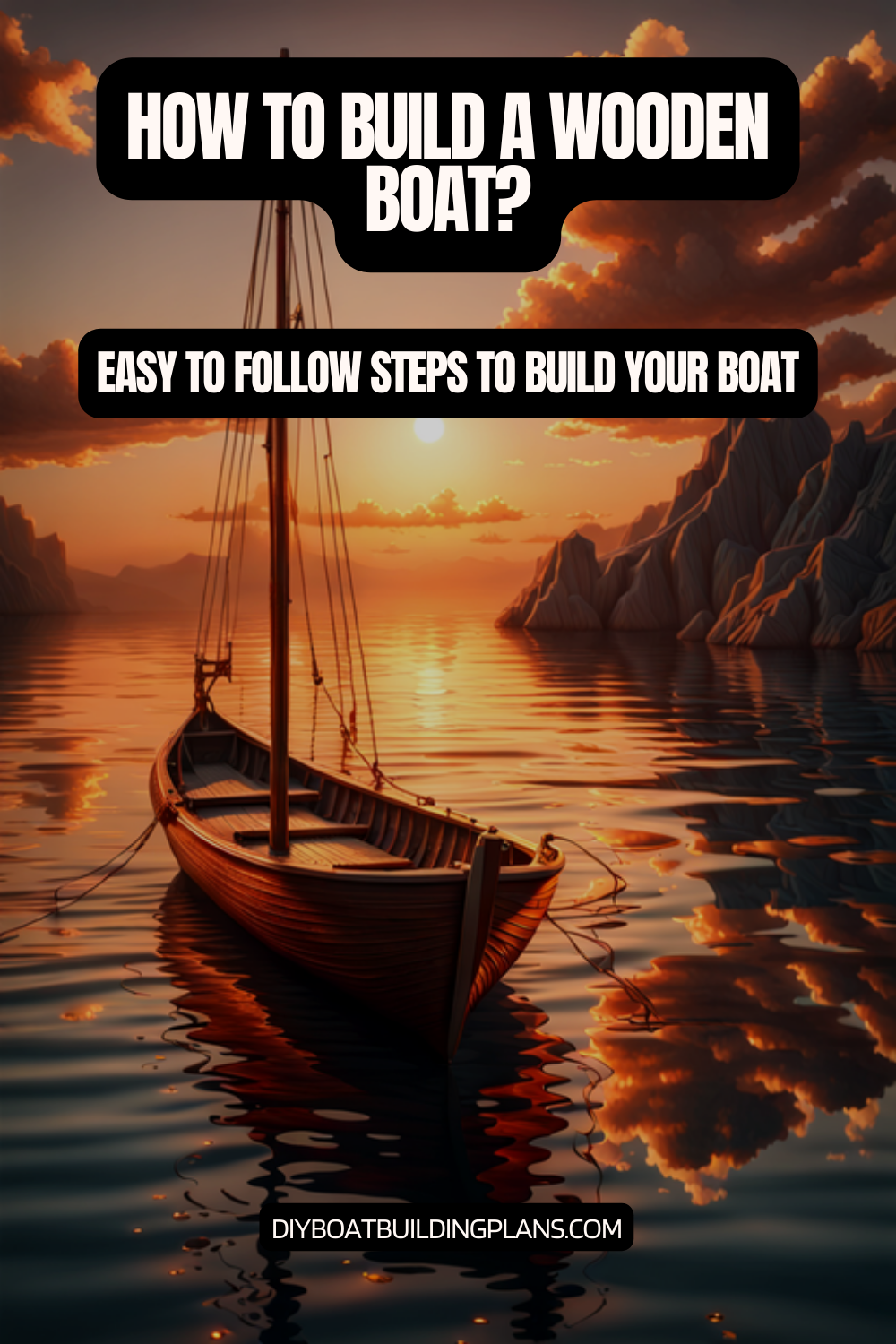Are you ready to turn your backyard into a wooden boat workshop? You can build a seaworthy vessel with your own hands. DIY boat building might seem hard, but with the right skills and passion, it’s possible.
Building a wooden boat at home needs dedication, skill, and creativity. The WoodenBoat School in Brooklin, Maine offers classes. They teach traditional hull construction methods, inspiring those who want to build a boat.
Wooden boat building has changed a lot, thanks to new materials like plywood and epoxy. Whether you dream of a small rowing boat or a big sailing vessel, knowing the basics is key to success.
Key Takeaways – How To Build a Wooden Boat
- DIY boat building requires patience and meticulous planning
- Multiple wooden boat construction techniques exist
- Professional training can significantly improve your skills
- Modern materials have revolutionized boat building
- Each boat project is a unique learning experience

Essential Tools and Materials for Wooden Boat Construction
Building a wooden boat needs careful planning and the right tools. Choosing quality equipment and materials is key. They must stand up to the sea.
Creating a wooden boat requires precision and the right tools. The right materials and tools are vital for a seaworthy vessel.
Power Tools and Safety Equipment
Always put safety first when using boat building tools. Essential safety gear includes:
- Safety glasses
- Respirator masks
- Hearing protection
- Work gloves
Power tools are essential for building a boat quickly. Key tools include:
- Orbital sander
- Jig saw with variable speed
- High-speed drill with various bits
- Carbide scraper
Basic Materials List
| Category | Recommended Materials | Purpose |
|---|---|---|
| Wood | Marine plywood | Hull construction |
| Fasteners | Robertson screws | Secure wooden components |
| Adhesives | Marine-grade epoxy | Waterproof bonding |
Specialized Boatbuilding Tools
Expert boat carpentry needs special tools beyond standard woodworking:
- Long ship augers (½-inch, 5/8-inch, 3/4-inch)
- Japanese crosscut saws
- Pipe clamps
- Bevel gauges
“The right tools make boat building not just possible, but enjoyable.” – Traditional Boatbuilder
Pro tip: Invest in quality tools and keep them in good shape. Most tools you need are affordable. But, spend on reliable brands for the most important ones.
Planning and Design Considerations
Building wooden boats needs careful planning and preparation. Home projects require a lot of attention to detail. The first step is to explore designs and study blueprints.
- Creating detailed hand-drawn or digital sketches
- Developing full-size cardboard mock-ups
- Measuring and verifying precise dimensions
- Generating templates for key components
“Proper planning prevents poor performance in boat building” – Traditional Boatbuilder’s Wisdom
Visualization is key in home boat projects. Making a cardboard mock-up helps builders see how things fit together. It also shows any problems before they start using expensive materials.
| Component | Critical Considerations |
|---|---|
| Center Rib | Structural integrity and symmetry |
| Transom | Strength and water resistance |
| Stem | Hull shape and alignment |
Precision is key in wooden boat designs. Builders should spend time making accurate cardboard templates. This ensures each part fits right before they start building for real. This way, they avoid mistakes and save materials in home projects.
Unlock the secrets to building your dream boat with MyBoatPlans! With detailed plans for over 518 boats and expert video tutorials, you’ll have everything you need to create your perfect vessel. Click here to begin your journey!”
Understanding Different Wooden Boat Construction Methods
Wooden boat construction is a blend of old skills and new ideas. It makes sturdy and lovely boats. Each method has its own strengths and looks.
There are many ways to build wooden boats. Builders pick based on their skills, the project, and what they like.
Carvel Planking Technique
Carvel planking is a timeless method. It’s been used for ages. Here’s how it works:
- Boats are built on a jig
- A solid backbone and frames are added
- Planks are put on, fitting together perfectly
Carvel planking makes smooth hulls. It’s great for all sizes of boats, from small dinghies to big schooners.
Traditional Lapstrake Method
Lapstrake is a traditional way of building boats. It uses overlapping planks. Here’s what makes it special:
- Planks overlap each other
- They’re aligned for a nice look
- It’s light, perfect for smaller boats
“Lapstrake boats show the best of traditional wooden boat making.”
Modern Construction Approaches
Today, there are new ways to build wooden boats. These include:
| Method | Characteristics | Best Suited For |
|---|---|---|
| Strip-planking | Uniform plank sizes | DIY builders |
| Stitch-and-glue | Fast and simple | Small projects, weekend builds |
| Cold-molding | Many wood layers | Complex designs |
Each method has its own benefits. Builders can choose the best one for their project and skills.
How To Build a Wooden Boat at Home
Building a wooden boat at home is a thrilling project. It needs precision, patience, and a love for making things. Starting a wooden boat project means planning well and following a clear path.
- Choose your boat design carefully
- Get the right woodworking tools
- Set up a dedicated workspace
- Make accurate measurements and templates
Wooden boat construction starts with a strong foundation. The first steps are making precise templates and learning about wood. Picking the right wood is key for lasting and strong boats.
“A well-built wooden boat is a testament to craftsmanship and maritime tradition” – Traditional Boatbuilders Association
For a successful boat project, consider these important points:
| Aspect | Importance | Recommended Action |
|---|---|---|
| Wood Selection | Critical | Choose marine-grade timber |
| Tool Preparation | Essential | Invest in quality woodworking tools |
| Workspace | Crucial | Ensure clean, dry, temperature-controlled area |
Building a boat at home needs commitment and a step-by-step plan. Every detail, from measuring to assembling, brings you closer to your dream boat.
Building the Boat Frame and Structure
Building a wooden boat needs careful carpentry to make it strong and reliable. The frame is the heart of your boat, affecting its strength, shape, and how it performs.
Creating a strong boat frame is a detailed process. It requires skill and focus. Experienced builders know how important a solid base is for the whole boat.
Creating the Transom and Center Rib
The transom and center rib are key parts in boat building. Here are some important tips to keep in mind:
- Use high-quality exterior plywood for durability
- Ensure precise cutting and alignment of boards
- Apply marine-grade adhesives for strong connections
- Check measurements multiple times before cutting
Installing Chines and Inwales
Chines and inwales add strength to the boat’s frame. They help spread weight and keep the boat’s shape during construction.
Precision is key when installing chines and inwales – every millimeter counts in boat building.
Framing and Support Systems
The framing process builds a strong support system. It must handle water pressure and environmental challenges. Boat carpentry suggests spacing ribs about 490mm apart for the best strength.
- Install stringers to support bottom planks
- Use marine-grade timber for maximum durability
- Ensure proper alignment of all structural components
With careful planning and execution, your boat frame will be a solid base for a great watercraft.
Planking and Hull Construction
Building a wooden boat needs careful carpentry skills. These skills turn raw materials into a strong vessel. The planking stage is key for the boat’s strength and how well it performs.
Download over 500 Boat Plans. Click on the link below.
-->Click Here<--
When building the hull, craftsmen must pick the right materials and use special techniques. For the best wooden boat construction, follow these steps:
- Prepare the boat frame with accurate measurements
- Select high-quality wood with straight grain
- Use appropriate fastening methods
- Ensure proper plank alignment
“Precision in planking is the difference between a good boat and a great boat.” – Traditional Boat Builder’s Wisdom
Planking in boat carpentry involves several important steps:
- Measure and cut plywood panels precisely
- Install the gunwale or rub rail
- Attach the keel strip, protruding approximately 15mm
- Use epoxy putty to seal screw rebates
| Planking Material | Thickness | Cost per Square Foot |
|---|---|---|
| White Oak | 1 3/8″ | $0.58 |
| Fir Plywood | 1/2″ | $1.43 |
Experts suggest using steam-bent planks and finishing by hand. The planking process can take 230 to 300 man-hours per strake. This depends on the boat’s design and complexity.
Fairing and Surface Preparation
Wooden boat maintenance needs careful surface prep for a top-notch finish. The fairing process makes rough surfaces smooth and precise. This defines a boat’s look and how it performs.
Boat carpentry requires exactness in the fairing stage. Skilled craftsmen use special techniques to make hull surfaces perfect. This boosts both looks and how well the boat moves through water.
Proper Sanding Techniques
Good sanding is key in building wooden boats. Experts suggest a step-by-step approach for surface prep:
- Begin with a long flat sander and 40-grit sandpaper
- Move to 80-grit for even smoother surfaces
- Use four smoothing planes for detailed hull fairing
- Plan on spending about 60 hours on fairing
Surface Finishing Methods
WEST SYSTEM epoxy offers top-notch fairing solutions for wooden boats. Their fillers have special benefits:
- 407 Low-Density Filler doubles the volume of original epoxy
- 410 Microlight Filler increases volume by two and a half times
- Works well with both dark and light topcoats
- Makes finishes that resist temperature changes
“Craftsmanship is key in fairing surfaces, where accuracy is vital for a great finish.”
Important tips for wooden boat care include using 2-inch bronze screws for plank fastening. Also, apply about six pounds of unspun caulking cotton during caulking. Proper surface prep ensures strong adhesion and a top-grade finish.
Installing Interior Components and Fittings
Building a DIY boat needs careful planning and precise installation. The interior of a wooden boat turns raw space into a cozy and functional place. Skilled builders focus on making efficient storage, comfy seating, and strong structures.
- Seat rails (15mm x 20mm)
- Keel strip (19mm wide)
- Stringers for bottom planking support
- Anchor lockers
- Berth spaces
Installing these parts requires great care. Boat builders usually:
- Notch out steps on inner ribs for seat rail placement
- Attach small lugs to transom for rail support
- Secure components using marine-grade epoxy and stainless steel fasteners
“Precision in boat interior fitting is not just craftsmanship—it’s a commitment to safety and performance.” – Master Boat Builder
In a 38-foot sailboat, making the most of interior space is key. The forepeak berths, at 7’2″, offer cozy sleeping spots with smart storage. Vee berths with watertight hatches underneath use every inch of space.
Features like water ballast tanks under the saloon seating show off advanced DIY skills. These tanks, with fiberglass baffle plates, help keep the boat stable and reduce water movement.
Pro tip: Always use marine-grade materials like silicon bronze bolts and consider dust-thickened epoxy for superior sealing and longevity.

Conclusion – How To Build a Wooden Boat
Building a wooden boat at home is more than a project. It’s an adventure that requires skill, patience, and personal touch. The process involves understanding each step, from choosing the right plywood to mastering stitch and glue techniques.
DIY boat building turns raw materials into a real boat through careful planning and precision. You’ll cut plywood, place center braces, and use epoxy and fiberglass tape for strong hull connections. Each step is a challenge that tests your woodworking skills and creativity.
The joy of finishing a wooden boat goes beyond the boat itself. It’s a personal victory, a link to traditional boat-making, and a chance to create something beautiful and useful. With patience, practice, and passion, anyone can make a stunning boat that shows their dedication and creativity.
Starting your boat-building journey means facing challenges that help you grow. Your wooden boat will be more than a way to get around. It will show your skill, hard work, and love for the sea.
FAQ – How To Build a Wooden Boat
How long does it take to build a wooden boat at home?
Building a wooden boat at home can take months to a year or more. It depends on the design, your skill level, and how much time you have. The complexity of the design, your woodworking skills, and how much time you can dedicate will affect the time it takes.
What are the most important skills needed for wooden boat building?
You need basic woodworking skills, patience, and attention to detail. Knowing how to use tools like power drills and sanders is key. If you’re new, consider taking classes at the WoodenBoat School to learn.
How much does it cost to build a wooden boat at home?
Costs can vary from $1,000 to $10,000 or more. This depends on the boat’s size, materials, and complexity. You’ll need to budget for wood, epoxy, fiberglass, tools, and finishing materials. Don’t forget to add extra for unexpected costs and tools you might need.
What type of wood is best for boat building?
Marine-grade plywood, cedar, oak, and mahogany are great choices. Marine plywood is water-resistant, while hardwoods are strong and durable. The best wood depends on your boat’s design, use, and local climate.
Do I need a workshop to build a wooden boat?
You don’t need a workshop, but a dedicated space is best. A garage, large shed, or covered outdoor area can work. Make sure it’s dry, well-ventilated, and has enough room to move and store materials.
What safety precautions should I take when building a wooden boat?
Always wear safety gear like safety glasses, breathing protection, and hearing protection. Work in a well-ventilated area, avoiding inhaling sawdust. Use dust collection systems or masks to prevent health risks.
Can a beginner successfully build a wooden boat?
Yes, beginners can build a wooden boat with the right preparation and patience. Start with simple designs, take classes, watch videos, and join boat building communities. Choose a design that matches your skill level and be ready to learn and adapt.
What tools are absolutely essential for wooden boat building?
You’ll need a power drill, hand planes, sanders, measuring tools, clamps, saws, and safety gear. Specialized tools like dividers and long flat sanders are also important. Invest in quality tools and learn how to use them properly for successful boat building.
How do I maintain a wooden boat after building?
Keep the boat clean, apply protective coatings, and check for water damage. Store it properly when not in use. Regularly inspect the boat for wear, repair any damage, and apply protective treatments to prevent wood deterioration.
What’s the most challenging part of building a wooden boat?
Maintaining symmetry, precise measurement, and fitting components can be tough. Achieving a smooth surface during planking is also challenging. The planning and design phase can be complex, requiring careful consideration of hull shape and structural integrity.



